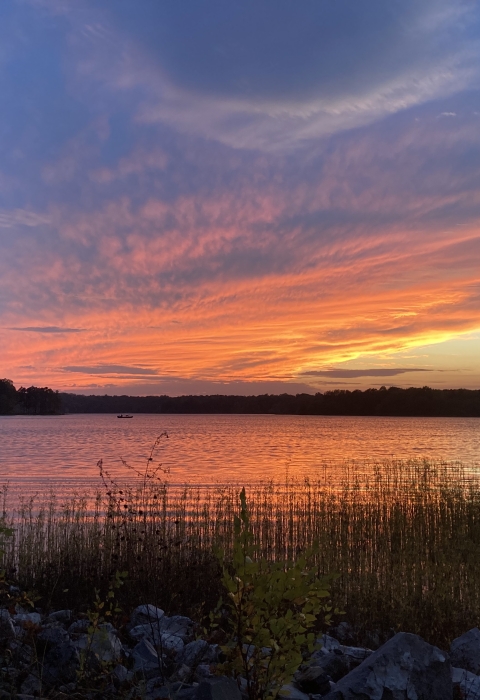Crab Orchard National Wildlife Refuge marked a milestone recently, celebrating its 75th birthday with a special day-long event. While we at the U.S. Fish and Wildlife Service recognize that all of America’s national wildlife refuges have special aspects, this refuge really stands out for its diverse mission and focus. Take a moment to learn more about this beautiful spot in Illinois.
To mark 75 years of conservation and recreation, refuge staff and members of the Friends of Crab Orchard Refuge welcomed the local community and partners to celebrate. Assistant Regional Director for the National Wildlife System Suzanne Baird reflected on the day, saying, “We have an outstanding team here at Crab Orchard. I’d like to thank the dedicated staff and volunteers working diligently to help meet the unique and complex purposes of this amazing refuge.”
Established on August 5, 1947, in southern Illinois, this 44,000-acre national wildlife refuge national wildlife refuge
A national wildlife refuge is typically a contiguous area of land and water managed by the U.S. Fish and Wildlife Service for the conservation and, where appropriate, restoration of fish, wildlife and plant resources and their habitats for the benefit of present and future generations of Americans.
Learn more about national wildlife refuge is the only one in the Midwest Region that has congressionally mandated purposes that are outside of the traditional focus of wildlife conservation and recreation. Land managers are also charged with managing agriculture and industry within the boundaries of the refuge.
The refuge is also home to more than 4,000 acres of congressionally designated wilderness and boasts a productive oak-hickory forest which is dominated by native species. White-tailed deer, hawks, owls and a variety of other migratory and resident forest birds make a home here.
All four seasons afford excellent opportunities to see wildlife. During the spring, large numbers of migratory songbirds pass through the forests and grasslands of the refuge, and many of these same species also breed here. Spring is also a great time to see wild turkeys at the refuge. The males are often seen strutting for females and putting on quite a show, while the females may be gathered in large groups along the wildlife drive both morning and evening.
During fall and winter, the lakes, ponds and wetlands on the refuge attract a wide variety of waterfowl and other waterbirds. White pelican numbers have been increasing here during the spring migration and have been extremely popular with visitors. American bald eagles breed on the refuge, and their numbers increase during the winter when additional eagles arrive as more northern waters freeze over.
Another special resident that you may see is the secretive bobcat. Keep an eye out for them along the auto tour route in the early morning. While they can be elusive, they are seen pretty regularly! If you’re lucky, you might see an armadillo when you visit. While they used to be a rare sighting, armadillos have been spreading north and east from Texas since the 1850s and are more common to see scurrying through the refuge.
Crab Orchard National Wildlife Refuge has a deep connection to World War II history. About half of the refuge was the former Illinois Ordnance Plant during the war. The plant was a large industrial complex with many buildings, miles of roads and railroads that made munitions for the war effort, including 500-pound bombs and landmines. During the peak of production, the plant employed about 10,000 people. Today, the industrial mission continues, but at a much smaller scale. These industrial activities have resulted in contamination with hazardous substances that have required extensive remediation and restoration efforts.
With the Carbondale-Marion metropolitan area directly adjacent to the refuge boundary, it’s no surprise that the refuge is a hotspot for recreationalists of all interests. Last year alone, the refuge tallied 1.2 million visits! Many of those were from repeat visitors who use the refuge often. Half of those visits involved observing birds and other wildlife.
People also come to the refuge for great fishing and hunting. This year the refuge welcomed 240,000 visits by anglers who came out to fish for largemouth bass, crappie and channel catfish. People also love to hunt for deer, upland game, furbearers and waterfowl at the refuge.
From on-site RV camping and motorized boating, to swimming, bicycling, picnicking, and even trail running, some people might confuse Crab Orchard for a national park. Given the size and multifaceted mission of the refuge, there is a little something for everyone.
Refuge Manager Justin Sexton is proud of the dedication and hard work that his team puts in every day and is pleased that so many local community members value the refuge.
“Big things are happening at the refuge! We’re excited to welcome visitors to the new 5,500-square-foot visitor center with brand new exhibits. We’re also looking forward to greater community connectivity through the Crab Orchard Greenway, a multi-use trail that will connect the refuge to Marion and Murphysboro, with multiple trailheads along the way,” said Sexton.
Crab Orchard National Wildlife Refuge is one of many facilities across the country benefiting from the Great American Outdoors Act Great American Outdoors Act
This landmark conservation law, enacted in 2020, authorizes the use of up to $1.9 billion a year in energy development revenues for five years for needed maintenance to facilities and infrastructure in our wildlife refuges, national parks, forests, recreation areas and American Indian schools.
Learn more about Great American Outdoors Act . The refuge received $24.9 million in funding to replace the original water and sewer utilities, build a new visitor center and assessing seismic issues. These projects are creating jobs and strengthening the local economy.
Learn more about Crab Orchard National Wildlife Refuge and start planning your trip!



